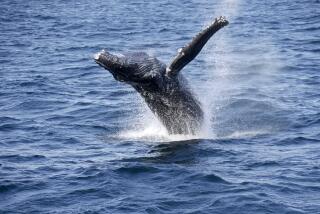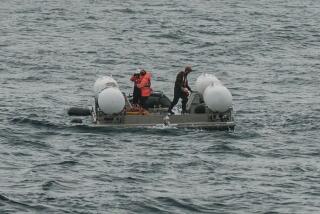Acoustic Signals Found : Underseas Eruption May Unlock Seismic ‘Warning’
The California scientist who watched an underwater volcano erupt beneath his research ship earlier this month believes he may have discovered the source of certain acoustic signals that have long baffled researchers in the South Pacific.
Harmon Craig, a geochemist at UC San Diego’s Scripps Institution of Oceanography, said Monday that the so-called T-waves observed by seismologists over the past 20 years appear to come from exploding bubbles of gas rising from the underwater volcano.
Craig said his finding suggests that acoustic equipment could be used to monitor the buildup of similar gas bubbles in volcanic lakes in Africa, perhaps making it possible to anticipate the kind of lethal gas emission from Lake Nios that killed 1,700 people in Cameroon in 1986.
“I think you could detect that with these T-waves,” said Craig, who intends to recommend that devices called hydrophones be placed in bodies of water like Lake Nios in Cameroon. “It didn’t occur to me before because we didn’t know the origin of these waves.”
‘Steaming Lava Balls’
Craig, who was chief scientist on an expedition to study volcanism in the South Pacific, found himself and the crew of the research vessel Melville directly above MacDonald Seamount 650 miles southeast of Tahiti as it was erupting Oct. 11.
In a radio report back to Scripps, Craig described how the ocean at first turned green then chocolate brown, swirling and boiling as gas bubbles rose to the surface, spitting forth “steaming lava balls too hot to hold in bare hands.”
“I felt like Pliny . . . the Roman scientist who saw the eruption at Pompeii,” Craig mused during his first meeting with reporters since returning to California on Saturday. “Only, he died because of it. I didn’t feel like going that far for science.”
Craig said the most important outcome of his leg of the expedition is his finding concerning the T-waves, acoustic waves first discovered traveling through the ocean more than 20 years ago but never fully explained.
The Importance of T-Waves
Craig said scientists discovered MacDonald Seamount in 1967 after observing T-waves coming from that direction.
Though the waves are acoustic, they can trigger seismic waves and be recorded by seismic monitoring devices on islands like Tahiti. Craig said they travel in the ocean’s so-called Sofar channel, which transmits sound over great distances.
“These bubbles come out and collapse in the water column as they come up . . . and those are the signals they’re seeing,” Craig said. “So it’s very interesting to know these signals are probably from bubbles because there are a great many applications that one can think of.”
Scientists disagree on the cause of the disaster, though they say the gas was primarily carbon dioxide. Some contend it came from molten rock deep in the earth; others say it came from decomposition of organic matter in the lake’s sediments.
“Now that I’ve seen these bubbles, these bubbles could be forming in these lakes,” Craig said Monday. “So a direct result of this work is going to be a suggestion that we put hydrophones in these volcanic lakes in Africa.”
More to Read
Sign up for Essential California
The most important California stories and recommendations in your inbox every morning.
You may occasionally receive promotional content from the Los Angeles Times.









